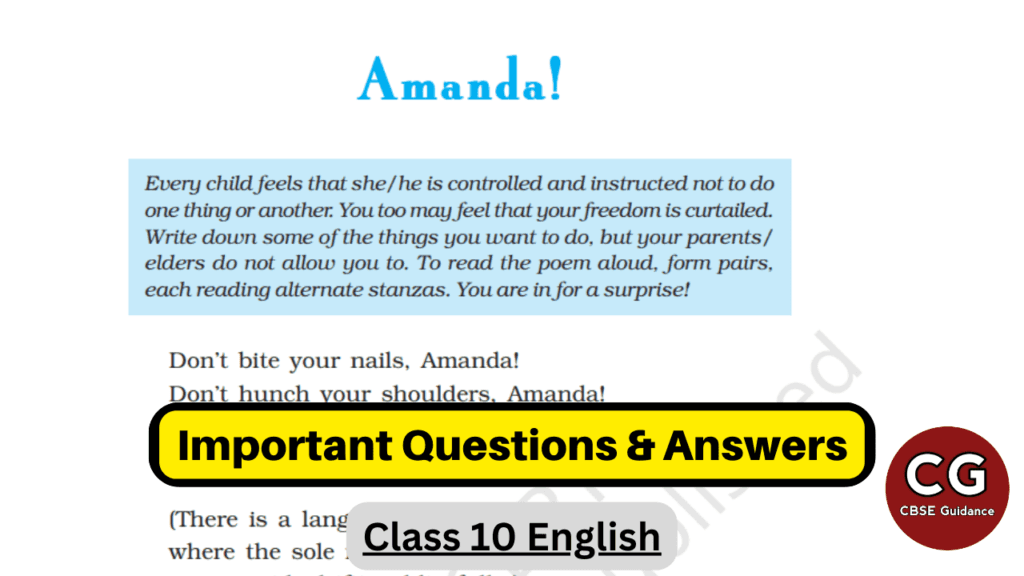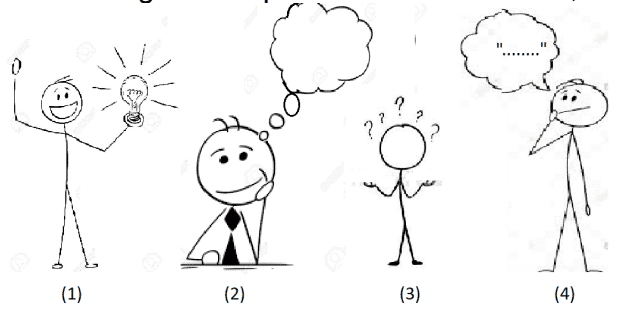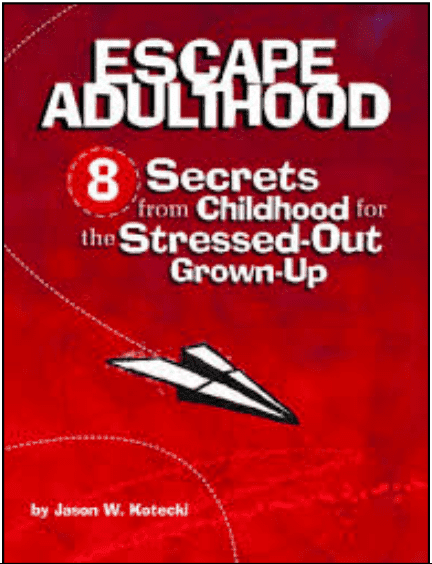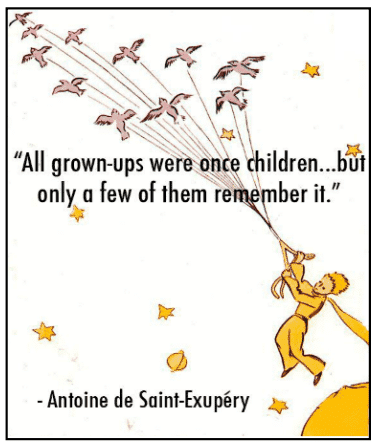Prepare for your CBSE Class 10 English exams with our comprehensive guide to 'Amanda.' Explore important questions and expert answers in this blog post, ensuring you're well-equipped for success!

| Subject | English Language & Literature |
| Class | 10 |
| Board | CBSE |
| Chapter Name | Amanda |
| Poet | Robin Klein |
| Type | Important Questions and Answers |
| Session | 2024-25 |
| Book Name | First Flight |
| Literature | Poem |
"Change is the end result of all true learning."
- Leo Buscaglia
Amanda Class 10 Important Questions Answers
Q. No. 1) Multiple Choice Questions based on an extract:
Don’t bite your nails, Amanda!
Don’t hunch your shoulders, Amanda!
Stop that slouching and sit up straight,
Amanda!
i. The purpose of the speaker’s words in the given extract is to
a. show the speaker’s power over the listener.
b. make the listener a better human being.
c. advise the listener as an elder.
d. improve the listener’s posture and habits.
Ans. Option (d)
ii. Pick the option that lists the image that correctly corresponds to the speaker’s mood in the extract.

a. Image (i)
b. Image (ii)
c. Image (iii)
d. Image (iv)
Ans. Option (c)
iii. Alliteration is a literary device used in the extract.
Which of the following options DOES NOT include examples of this literary device?
a. The moon and the shimmering stars watched over us
b. With that charming chat, Catherine chose comfort
c. Away ran the pathetic pooch pouting like a princess
d. Dee dee was driving down day after day
Ans. Option (a)
iv. What does the repetition of “Amanda!” at the end of each line reflect?
a. It describes who the speaker is talking to.
b. It represents the absent-mindedness of the listener.
c. It shows the frustration of the speaker.
d. It helps create a rhyme scheme.
Ans. Option (c)
v. Select the option that fits with the following:
slouching : straight:: ______ : _______
a. transparent: translucent
b. lazy: agile
c. forgetful: lively
d. generous: liberal
Ans. Option (b)
Q. No. 2) Multiple Choice Questions based on an extract
(I am an orphan, roaming the street.
I pattern soft dust with my hushed, bare feet.
The silence is golden, the freedom is sweet.)
i. The tone of the given lines is
a. analytical.
b. despairing.
c. peaceful.
d. nervous.
Ans. Option (c)
ii. Read the statements A and B given below, and choose the option that correctly evaluates these statements.
- Statement A – The figure ‘I’ imagines a less-than-realistic view of being an orphan.
- Statement B – The figure ‘I’ does not like the speaker.
a. A is true, and B is false, according to the extract
b. A is true, but B cannot be clearly inferred from the extract.
c. A cannot be clearly inferred from the extract, and B is false.
d. A is true and can be inferred from the poem, B is true too.
Ans. Option (b)
iii. The golden silence is contrasted with the __________.
a. chaos of the street.
b. constant instructions received.
c. sweetness of freedom.
d. hushed, bare feet.
Ans. Option (b)
iv. The rhyme scheme ‘aaa’ in the above extract is followed in all other stanzas of the poem that are written in parenthesis, i.e. (). Why?
Read the reasons given below, and choose the option that lists the most accurate reasoning:
- It shows the simplicity of the child’s thoughts.
- It reflects the harmony and rhythm of the child’s inner world.
- It mirrors a child’s expression.
- It highlights the poet’s aesthetic sensibility.
a. (1) and (4)
b. (1) and (2)
c. (2) and (3)
d. (3) and (4)
Ans. Option (c)
v. Pick the option that lists the usage of the word ‘pattern’, as in the extract above.
a. That is a lovely pattern for wallpaper.
b. He decided to wear a patterned shirt to the party.
c. Poetry is a form of pattern making.
d. She patterned her hair after her favorite celebrity.
Ans. Option (d)
vi. Which option completes the popular adage given below?
___________________ silence is gold.
a. Precious are words for
b. Speech is silver
c. Silver is the tongue
d. Ideas may be precious but
Ans. Option (b)
vii. A transferred epithet is a literary device where the modifier or epithet is transferred from the noun it is meant to describe to another noun in the sentence.
Based on the given definition of ‘transferred epithet’, choose the option that lists an example of a transferred epithet.
a. soft dust
b. hushed (bare) feet
c. freedom (is) sweet
d. silence (is) golden
Ans. Option (d)
viii. Which image corresponds to what Amanda, is doing in this extract?

a. option 1
b. option 2
c. option 3
d. option 4
Ans. Option (b)
Q. No. 3) Multiple Choice Questions based on an extract:
(I am Rapunzel, I have not a care;
Life in a tower is tranquil and rare;
I’ll certainly never let down my bright hair!)
Stop that sulking at once, Amanda!
You’re always so moody, Amanda!
Anyone would think that I nagged at you, Amanda!
(Amanda!)
i. Which of these reflects the speaker’s tone in the second stanza of the extract?
- critical
- worried
- concerned
- sympathetic
- commanding
a. 1, 5
b. 2, 3
c. 2, 4
d. 4, 5 1
Ans. Option (a)
ii. Why has line 6 of the extract been referred to as ironical?
Ans. Line 6 of the extract is ironic because the speaker is doing what she says she is not doing, that is, nagging Amanda.
iii. Identify the reason Amanda says she will never let down her hair.
a. She has very short hair.
b. She likes her hair a lot.
c. She wishes to be left alone.
d. She awaits her Prince Charming.
Ans. Option (c)
iv. Complete the analogy with a word from the extract.
life: death:: grinning: __________
Ans. sulking
v. Select the sentence in which the word ‘bright’ is used in a similar manner as line 3 of the extract.
a. Sekhar is a very bright child.
b. Rama looked bright and chirpy today.
c. Bobby's shirt was so bright and cheerful.
d. Hemant has such bright prospects for the future.
Ans. Option (c)
Q. No. 4) Would you call Amanda a disrespectful child? Provide one reason to justify your opinion.
Ans. No, Amanda is not necessarily a disrespectful child. She daydreams as a coping mechanism to deal with constant criticism, seeking solace in her imagination.
Q. No. 5) What kind of an image does “languid, emerald sea” evoke?
Ans. The phrase "languid, emerald sea" evokes an image of a calm, slow-moving, and tranquil sea with a vibrant greenish-blue color, suggesting a peaceful and serene atmosphere.
Q. No. 6) What does the line “never let down my bright hair” tell us about Amanda?
Ans. The line "never let down my bright hair" suggests that Amanda is determined to maintain her independence and not succumb to external pressures or demands placed upon her.
Q. No. 7) The reader sympathizes with the speaker in the poem. Support this opinion with a reason.
Ans. The reader sympathizes with the speaker in the poem because the speaker's constant nagging and criticism of Amanda appear excessive and unrelenting, making Amanda's daydreams an understandable escape.
Q. No. 8) What do you think is the significance of the exclamation mark in the title of the poem ‘Amanda!’?
Ans. The exclamation mark in the title "Amanda!" signifies the speaker's insistence and perhaps frustration in trying to get Amanda's attention or convey their message, highlighting the intensity of the speaker's tone.
Q. No. 9) How would you characterize the speaker in the poem ‘Amanda!’? List any two qualities, supporting the reason of your choice, with evidence from the poem.
Ans. The speaker in the poem "Amanda!" can be characterized as critical and demanding.
- Critical: The speaker repeatedly points out Amanda's flaws and shortcomings, such as biting nails, slouching, eating chocolate, and sulking. This critical tone is evident throughout the poem as the speaker continually scolds Amanda.
- Demanding: The speaker demands Amanda's attention and compliance by using exclamation marks and questioning her actions, such as asking if she finished her homework, tidied her room, or cleaned her shoes. The tone is insistent, reflecting the speaker's demanding nature.
Q. No. 10) ‘Amanda is alone but not lonely in the world she envisions.’ Justify the statement with reference to any one image she pictures in her mind.
Ans. Amanda is alone but not lonely in the world she envisions, such as when she imagines herself as a mermaid drifting in a "languid, emerald sea." In this image, Amanda finds solace and contentment, indicating that her imaginative world provides her with a sense of companionship and fulfillment, despite her physical solitude.
Q. No. 11) Comment on the tone of the speaker when she says ‘Will you please look at me when I’m speaking to you, Amanda!’.
Ans. The tone of the speaker when she says "Will you please look at me when I’m speaking to you, Amanda!" is annoyed and irritated. The use of the exclamation mark emphasizes the speaker's frustration and annoyance, as they are seeking Amanda's attention and compliance, but she continues to daydream and ignore their pleas.
Q. No. 12) This is Calvin, a character from a comic strip created by Bill Watterson. Do you think this might be something Amanda would say? Why/ why not? Give reasons.

Ans. Amanda's tendency to escape into her imaginative worlds in the poem suggests that she might resonate with the sentiment expressed by Calvin: "It's not denial, I am just very selective about the reality I accept." This is because Amanda uses her daydreams as a coping mechanism to deal with the constant criticism and demands placed upon her by the speaker. She selectively embraces the imaginative reality she creates to find solace and freedom from the real world's pressures and negativity.
Q. No. 13) Justify the poet’s allusion to Rapunzel in ‘Amanda’.
Ans. It is justified as Rapunzel lived with a witch who would constantly keep a check on her and had several rules to follow.
-Amanda too, feels caged by the impositions
-Amanda desires peace in isolation like Rapunzel had in her tower; clarifying she will not let her hair down for anyone
Q. No. 14) What advice might “chatterbox” Anne (Frank) have for the quietly imaginative Amanda? Present this as a conversation between the two.
You may begin this way:
Anne: Gosh! You do run off into some strange worlds, don’t you?
Amanda: (nods) Well…
Ans. Anne: Gosh! You do run off into some strange worlds, don't you?
Amanda: (nods) Well…
Anne: I get it. Life can be overwhelming, and sometimes, escaping into your imagination is a way to cope. But remember Amanda, while daydreaming is nice, don't forget to engage with the real world too.
Amanda: How do you do it, Anne? You wrote so much, even in such a difficult situation.
Anne: Writing was my way of making sense of the world and keeping a record of my thoughts and feelings. It helped me stay connected to reality, even when it was tough. Maybe you can try expressing your thoughts and dreams through writing or art.
Amanda: That sounds interesting.
Anne: And don't be afraid to share your thoughts with others. Sometimes, a little conversation can bring you back to reality while still keeping your imagination alive.
Amanda: Thanks, Anne. I'll give it a try.
Anne: Good. Remember, balance is the key to a fulfilling life.
Q. No. 15) Colin Wilson, an English author, said, “Your imagination should be used not to escape reality but to create it.”
Compare/contrast Wanda and Amanda in the light of this author’s opinion.
Ans. Colin Wilson's quote, "Your imagination should be used not to escape reality but to create it," sheds light on the differing approaches of Wanda and Amanda in the poem.
Wanda, in her imaginative stories about her hundred dresses, uses her creativity to contribute positively to her reality. She creates beautiful dresses in her mind, fostering hope and self-expression despite her impoverished circumstances. Her imagination becomes a source of inspiration for her and those around her.
On the other hand, Amanda tends to use her imagination to escape the harsh reality imposed by the speaker's constant criticism. While Amanda's daydreams provide her with solace, they are more about evasion than creation. Her imagination is a retreat from reality rather than a means to actively shape it.
In essence, Wanda's imagination aligns more closely with Wilson's perspective, as she employs it to enrich her life, while Amanda leans towards escapism.
Q. No. 16) Look at the given image of a book cover. If the author, Jason Kotecki were to ask a grown-up Amanda to help with his book by writing one of the 8 secrets based on her experiences, what might she share? Elaborate based on your understanding of the poem.

Ans. If Jason Kotecki were to ask a grown-up Amanda for her input on his book "ESCAPE ADULTHOOD: 8 Secrets from childhood for the stressed out grown-up," she might share a secret related to the power of imagination and the importance of retaining a childlike sense of wonder.
Amanda, based on her experiences in the poem, has a profound ability to escape into her imagination as a means of finding solace and tranquility amidst the demands and criticisms of adulthood. She might emphasize the value of setting aside time for daydreaming, creative thinking, and escaping the stressors of daily life. Amanda could suggest that nurturing one's inner child, allowing moments of imaginative play, and embracing a world of make-believe can provide adults with a much-needed break from the pressures of grown-up responsibilities.
In essence, Amanda's secret might revolve around the idea that retaining a connection to one's childhood imagination can be a powerful tool for reducing stress and finding moments of joy and relief in the midst of adult life's challenges.
Q. No. 17) Read the quote given below carefully. Based on your understanding of the poem, explain how and why this quote can be applied to the poem.

Ans. The quote, "All grown up were once a child… but only a few of them remember it," can be applied to the poem because it underscores the central theme of the poem, which is the contrast between the imaginative, childlike perspective and the pressures of adulthood.
In the poem, Amanda represents the child who still remembers the innocence, wonder, and imaginative world of childhood. She escapes into her daydreams to preserve this connection to her inner child. The speaker, on the other hand, symbolizes the adult who has forgotten or disregarded the importance of retaining that childlike perspective. The speaker's constant criticism and demands reflect the stress and seriousness of adulthood.
The quote suggests that Amanda's ability to embrace her inner child through daydreams is a valuable quality that many adults lose touch with as they grow up. Amanda's contrasting world of imagination serves as a reminder of the innocence and creativity of childhood, which can offer solace and relief from the burdens of adulthood.
Q. No. 18) You have been asked to present an evaluation of the approaches of the mothers of both, the baby seagull and Amanda, towards helping their children. Write this presentation draft including your insights, in about 120 words, comparing the approaches of both parents.
You may begin this way:
One acknowledges that both parents, Amanda’s mother, and the baby seagull’s mother both....however, ...
(Reference -Amanda! & His First Flight)
Ans. The baby seagull’s mother:
The baby seagull’s mother was a parent who wanted to better her child's life by pushing him out of his comfort zone and encouraging him to learn new skills. She believed that her son is capable of flying, even though he was afraid, and tried to motivate him by showing him how much fun it could be. She also offered him scraps of fish to reward him for his efforts, which is truly a kind of positive reinforcement strategy.
However, the mother's approach also had some drawbacks. By constantly pushing the baby seagull to fly, she was putting him in danger and risking his physical well-being. She also didn't seem to acknowledge his fear and anxiety, which could be a source of stress for the baby seagull.
Amanda’s mother:
Amanda's mother is depicted as a strict and critical figure who is presented as always correcting Amanda's behavior, from her posture and habits to her academic performance and personal hygiene.
While her intentions may be good, her methods are shown to be ineffective, and in some cases, harmful. By constantly nit-picking Amanda's behavior, her mother creates an atmosphere of tension and anxiety, which only serves to make Amanda feel worse about herself. This also causes Amanda to feel like she can never measure up, leading her to seek solace in imaginary worlds and fantasies.
The methods of Amanda's mother do not come across as conducive to achieving this goal. Rather than focusing on Amanda's strengths and encouraging her to develop them, she highlights her weaknesses and shortcomings. Amanda is thus, left feeling undervalued, which could have a negative impact on her self-esteem and mental health.
Comparison:
In comparison to Amanda's mother, the seagull's mother seems to be more attuned to her child's needs and abilities. She recognizes that the baby seagull is capable of flying and wants to help him achieve his full potential. However, she may not be taking into account his fears and anxieties, which can be just as important to his well-being as his ability to fly. In contrast, Amanda's mother seems to be too focused on correcting her daughter's flaws and may not be paying enough attention to her strengths and abilities.
Even though both mothers have good intentions and want to better their children's lives, their methods, in part, may be misguided or ineffective. The seagull's mother could benefit from being more sensitive to her child's emotions, while Amanda's mother could benefit from focusing on her daughter's strengths and building her self-esteem.
Ultimately, the best approach for both parents would be the one that would balance positive reinforcement with sensitivity to the child's needs and limitations.
Hope you liked these Important Questions & Answers on Class 10 English First Flight Book Poem Amanda by Robin Klein. Please share this with your friends and do comment if you have any doubts/suggestions to share.